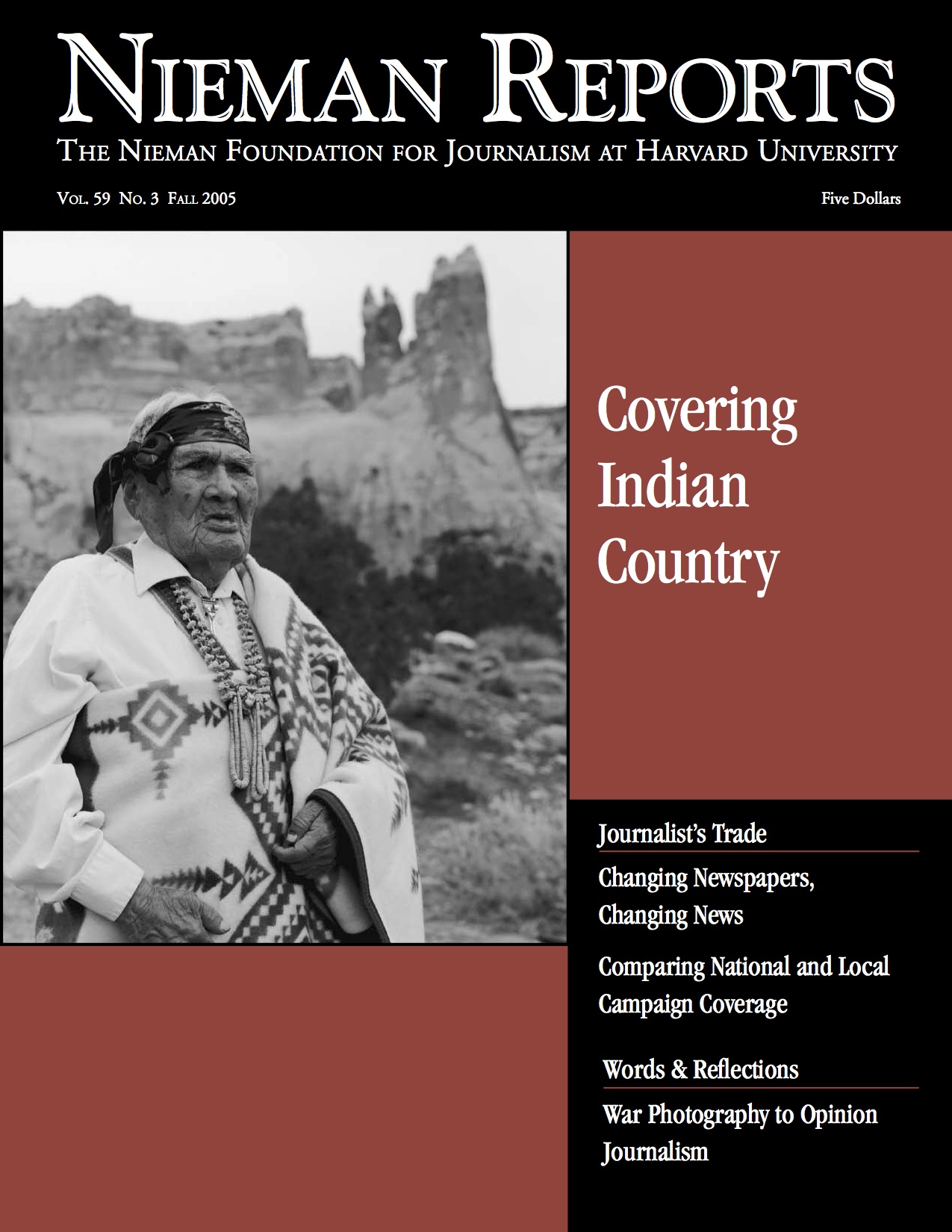Jodi Rave, who reports on Native issues for Lee Enterprises, describes some difficulties Native and non-Native journalists confront in reporting about what happens in Indian Country. Because the financial survival of the majority of tribal newspapers depends on tribal support, “newspaper editors tend to stay away from news that calls tribal leaders into question.” This absence of watchdog oversight has consequences for the tribe’s citizens whose lives are affected by policies and decisions made by tribal leaders. In non-Native media, “native voices … rarely seem to permeate the daily news pages.” The consequence is that “stories tend to be written with a confined perimeter, written without context, and written based on generalities.” Photographs by Ken Blackbird accompany her words and appear with other articles.
For nearly 30 years Bonnie Red Elk reported for and served as editor of the Wotanin Wowapi, the tribal newspaper on Fort Peck Reservation in northeastern Montana. Early on she attended tribal government meetings, and the paper published what she witnessed during the council’s deliberations. In time, complaints about such watchdog reporting were voiced by council members, yet as editor she continued this coverage. Red Elk writes about her tumultuous journey at the Wotanin as she worked to maintain the newspaper’s independent voice. Tim Giago created the Lakota Times, which “became the only independently owned Indian weekly publication in America,” and he speaks to the financial and community barriers to a free press in Indian Country. As he explains, “Some newspapers have crossed editorial swords with tribal leaders and vanished.”
Writing from the perspective of a non-Native who has reported extensively about Indian Country, Steve Magagnini, a reporter at The Sacramento Bee, offers tips he has learned through trial and error. One lesson: “The key seems to be to present Indian perspectives—and to write about solutions as well as problems, renaissance as well as dissonance.” When non-Native Larry Oakes returned to the Leech Lake Ojibwe Reservation, where he’d lived as a child, he was there to report a story for the Star Tribune in Minneapolis, Minnesota about an upsurge in youth violence and in their abuse of alcohol and drugs. After “The Lost Youth of Leech Lake” was published, the tribal council convened a two-day public forum to “change the perception” the articles had created. Oakes tells what happened as the articles’ words and photographs taken by Jerry Holt forced discomforting issues to the surface. Michael Moore, a reporter at the Missoulian in Missoula, Montana, went to the Flathead Indian Reservation because of the alcohol-related deaths of two 11-year old boys and ended up devoting four months of time to reporting on the complex circumstances of children’s lives on this reservation for a series entitled “Lost Boys of the Flathead.” As Moore writes, “To report this story well, we needed to slow down.”
Mary Ann Weston, author of “Native Americans in the News” and an associate professor emerita at the Medill School of Journalism, explains why journalists—past and present—“have largely failed to tell Native Americans’ stories fully, accurately and, sometimes, at all.” When a school shooting took place on Red Lake Indian Reservation in March, editors and reporters at the Grand Forks (N.D.) Herald relied on the reporting expertise of columnist Dorreen Yellow Bird and the trust she’d built with members of this tribe from coverage of the reservation’s less dramatic stories. Yellow Bird shares her observations—and disillusionment—about the news media’s coverage of tribal events. Dan Gunderson, a reporter with Minnesota Public Radio, also reported on the Red Lake shootings, and he describes the cultural clash he saw as reporters tried to report the story without their customary access due to tribal sovereignty. American Indians, he writes, “place high value on respect and trust and inherently distrust people when they show up asking questions and demanding answers.”
Mark Trahant, editorial page editor at the Seattle Post-Intelligencer and author of “Pictures of Our Nobler Selves: A History of Native American Contributions to News Media,” explores the consequences of Natives not being among those journalists who report for TV or radio stations and says improvement won’t happen “until TV news recognizes the depth of the problem.” Victor Merina, an editor for reznet, which provides online coverage of Native issues through a college network of Native reporters and photographers, writes about the valuable role the Internet is playing as it becomes “a conduit for Native Americans to tell their individual and collective stories—and for journalists to print and broadcast them.”
Based at the University of Montana School of Journalism, Denny McAuliffe is reznet’s project director. He describes the varied paths that Native youngsters take in becoming journalists, including two targeted initiatives—a summer training institute and the online network (reznet)—that provide much-needed opportunities. With its wide reach, reznet is allowing Native college students to become tribal youth’s “missing role models.” At this school, journalism professor Carol Van Valkenburg also directs the Native News Honors Project in which Native and non-Native students learn how to find and tell stories in Indian Country, go to reservations to do their reporting, and publish their work with a focus on such complex topics as tribal sovereignty and race. In describing the students’ award-winning work, Van Valkenburg says, “They are hard hitting, insightful and in-depth stories about people whom the students spent time talking with and observing.”
Anne E. Pettinger was among Van Valkenburg’s students who set out last spring to report on an aspect of race affecting tribal members at Rocky Boy’s Reservation near Havre, Montana. After researching the topic and hearing about tensions between Natives and business people in Havre, she and student photographer Katie Hartley set out to learn more about these interactions. The tensions and incidents that Pettinger’s story “Bordering on Racism” featured brought swift reaction from community leaders and pledges of change. “The assignment illustrated the wealth of stories waiting to be reported from these communities,” Pettinger concludes.


